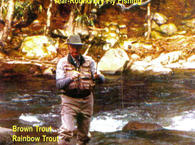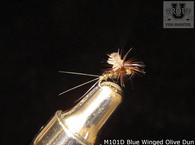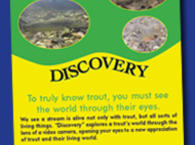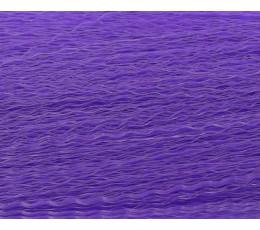The Snake River is a freestone stream that lies in the extreme Southeastern area of the Yellowstone National Park. The Snake River starts by combining many small feeder streams just below the Continental Divide.. The two largest tributaries are the Heart River, a four mile long river, which intersects the Snake River about 15 miles from the South Entrance and the Lewis River which intersects the Snake River just above the South Entrance of the Yellowstone National Park. The Snake River is one of the master streams in this most remote area of the park and it also becomes a master stream in southern Idaho.
From the confluence with the Lewis River, the Snake River flows through 9 miles of meadows where it is regarded as an excellent beginner’s stream. That is because it is inhabited mostly with 10 to 15 inch cutthroats that are not too proud to take a dry fly. The large dry flies need not necessarily need to be in a dead drift either. The next two miles flow through a canyon and then it flows through about 4 miles of meadow before the confluence with the HartRiver. Above the confluence with the HartRiver, the stream is small, hard to access, and receives little pressure. This area of the river is for the most capable hikers and campers.
Fishing the Snake River:
The natural insects such as the mayflies, caddsis and stoneflies are very active on the surface of the water
creating a 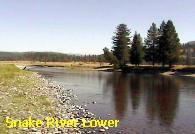
great opportunity for using dry flies. Because of this Snake River characteristic, the recommendation is to start with dry flies and switch to nymphs or streamers only if the dry flies do not yield trout strikes.
While the most proficient size fly is hook size #18, in the lower reaches of the Snake, the cutthroat’s love of large day flies extends up to hook size #6 and even on occasion, up to size #4. The dry flies can be drifted down stream with only little regard for a dead drift. Often times, a twitch caused by lifting the rod tip will entice a spectacular and violent top water strike
Spring:
The trout season on the Snake opens on April 1 and the pre-runoff season until mid May provides an excellent opportunity. The first hatches of the year are the March Browns and the Blue-winged Olives. These hatches will last through the end of April. The last week of April through the month of May will see the “Mother’s Day Hatch” of the Grannom (Branchycentrus species) caddis fly.
Summer:
Runoff typically extends well into July and some years when the snowfall is heavy, the runoff will extend into August. The Pale Morning Duns, the caddis and the stonefly hatches are occurring in the first weeks of June while the river is still in full runoff and they will continue through the first two weeks of September. After the river clears in late July or August it is prime time for those large dry flies to be effective and they will work even if wet. Hoppers, ants and other terrestrials will also be effective since so much of the Snake River runs through meadows.
Fall:
September is often considered the best time to fish the Snake. Hatches like the Mahogany Dun will continue, but consider the terrestrials, and the streamers such as the Wooly Buggers or Muddler Minnows. Don’t forget the nymphs with or without bead heads, fished down low, and slow will also bring strikes.
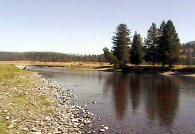
 great opportunity for using dry flies. Because of this Snake River characteristic, the recommendation is to start with dry flies and switch to nymphs or streamers only if the dry flies do not yield trout strikes.
great opportunity for using dry flies. Because of this Snake River characteristic, the recommendation is to start with dry flies and switch to nymphs or streamers only if the dry flies do not yield trout strikes.

